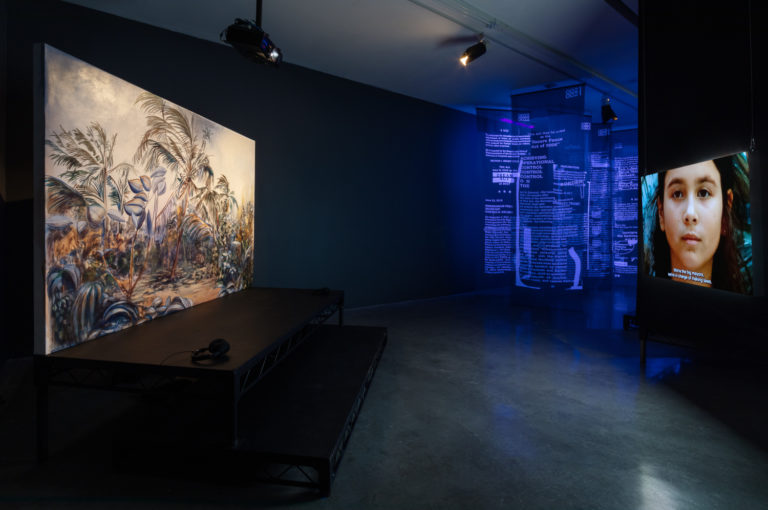The path through this darkened labyrinth is reminiscent of the Haunted House; the viewer is made to follow a path through concocted fear toward anticipated relief. Chiron, Adelita Husni-Bey’s immersive environment, however, refuses to allow the visitor to leave so easily. Her horrors are real, historically, contemporarily real and the exit is much farther away than it appears, if there is an exit at all—emerging into the light does not necessarily illuminate.
Assembled in three distinct chapters, the installation includes Chiron (2019), a video projection flanked by a sculptural text component; 2265 (2015) a speculative fiction concerning imperialism/capitalism performed by high school students, presented on facing monitors; and Postcards from the Desert Island (2011) a workshop with French elementary school students debating the best strategy of making a new and more equitable civilization. Linked by social justice, or the lack of it, the overall manifestation is one of hopeful simplicity and tragic realization.

Adelita Husni-Bey: CHIRON (2019). Installation view at REDCAT, Los Angeles. Photo: Brica Wilcox
Chiron, named after the wise centaur from Greek mythology who rejected the raucous self-indulgence of his fellows and became a teacher and healer, introduces itself through a cataract of banners stretching from ceiling to floor, text-laden and glowing in the darkness. Reading them is an education (or more likely a reminder of things which we were well aware of but have little time to contemplate because they don’t affect people like us) in the selective legal policies that have manipulated the number of and conditions regarding immigrant acceptance and residence in the United States. These texts, their luminous letters glowing under ultraviolet light, include the Scott Act of 1888, a sequel to the Chinese Exclusion Act of just six years before, disallowing the prospect of return should one of these aliens ever travel outside the U.S.; the Page Act had banned Chinese women 13 years prior. The opposite side of the gallery features banners of more recent anti-immigrant lawmaking, featuring enhanced death penalties and deportation provisions. Additionally, a video shows immigration lawyers participating in a workshop to more fully understand the mental toll that afflicts people trapped in the willfully capricious maze of immigration.
The high school students in 2265 step away from the present and into a fantasy future that initially promises a benefit from lessons learned. This notion is short-lived as even their brave new world is born as a more virulent, technological dystopia.
Postcards from the Desert Island provides a less cynical outcome: our grim today becomes these children’s complex but hopeful tomorrow as they debate egalitarian economy, create trade and infrastructure, and even confront growing greed and inequality. They, sadly, will be Orpheus, resigned to the fact that Eurydice is forever lost.


